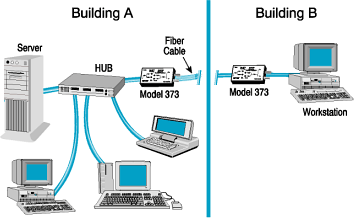
When Local Area Networks (LANs) are implemented, there always seem to be
one or more stations which are isolated from where the 'action is,' one
or more stations which are far from the Ethernet hub. These isolated
stations may be in a separate building from the Ethernet hub or they may
even be across an industrial campus. Including these isolated stations
in the LAN presents a real 'headache' when it is implemented using
10Base-T, twisted pair, copper cable, technology. The maximum distance,
which really is set by the CSMA cable sharing protocol, is only 100
meters. This hardly allows including isolated stations in the LAN.
The Model 373 is just the right 'pain killer' to end this 'headache.' It
will allow you to connect an isolated station to the LAN using low cost,
multi-mode, fiber optic cable. While meeting the CSMA requirements, the
low cost, multi-mode, fiber optic cable allows the isolated stations to
be extended a full 2 km from the hub. Of course, you will need a Model
373 at isolated station end to convert the electrical signal to/from
copper to light for fiber optic transmission. You will also need another
Model 373 at the hub end to do the same conversion-unless the hub has
this already built-in. This is just like the illustration shows. Using
the Model 373 allows you to get significant range extension with your
LAN.
The conversion is fully 10Base-FL compatible so you can communicate with
another vendor's 10Base-FL compatible equipment, having a truly open
architecture. You will get some additional side benefits from using
fiber optic cable to do the LAN extension. You will become immune to
interference caused by lightning strikes - a real problem when you are
transmitting LAN signals between buildings. You will also have total
electrical isolation with the fiber optic cable and not have to worry
about grounding problems. This is still another 'headache' when you have
different elements of a network connected to different physical grounds,
as often happens when you go between buildings.
|


